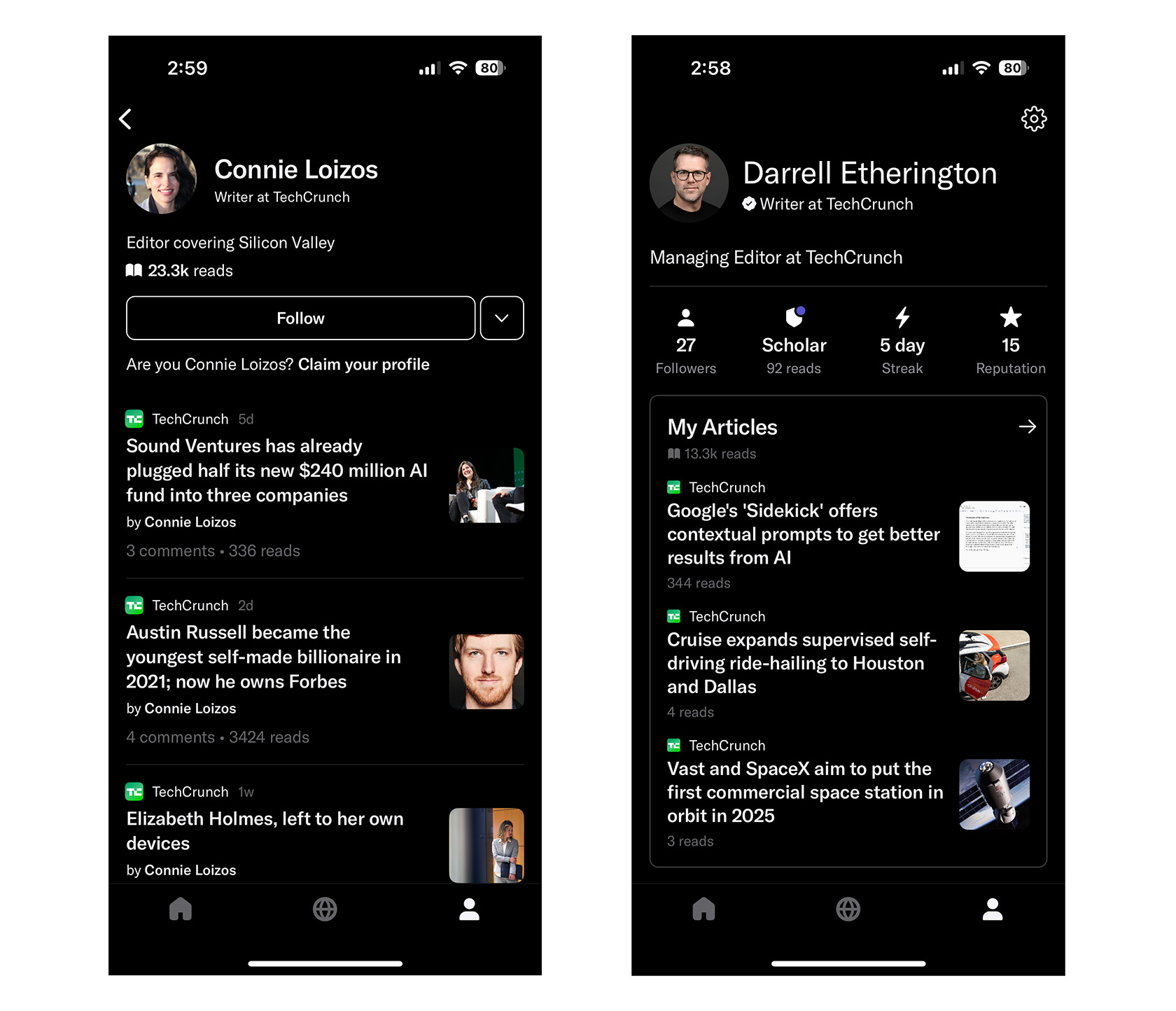Instagram co-founders Kevin Systrom and Mike Krieger have already shipped a ton of substantial updates for their news-focused app Artifact, which launched earlier this year but already looks very different from what debuted in January. On top of allowing users to follow writers on the platform, the latest update also provides a way for writers to claim their own profiles, upload a profile picture and fill out a bio, as well as gives them access to some basic stats about how their work is performing with the Artifact community.
I spoke to Systrom about the new features and about Artifact’s decision to focus on serving writers as a top priority, rather than just readers or consumers. Systrom sees writers as key to the platform’s growth, and he also believes Artifact can serve them in a way that no other platform or publishing paradigm has done to date.
“From the writer side, it feels to me like there’s this trend of writers building more independent followings on Substacks, building more independent followings on Twitter, just for breaking news,” Systrom said. “The real issue with all of these is the lack of distribution, meaning like, if you want to create a following, how do you do it?”
The idea is to build a connective layer between writers and their readers that doesn’t limit them to just one publication platform, like Substack, and that also doesn’t just happen to work for this purpose but is actually designed for myriad other things (like Twitter).
“Maybe what we could do is create this marketplace where we match consumers with the writers of the things that they love reading, and we can build a following for these writers on Artifact,” Systrom explained regarding their thinking about where Artifact could go from here.
Systrom immediately acknowledges that writers won’t find followings anywhere near comparable to those they might have built on Twitter or Substack on Artifact right now — but he notes that they only launched three-and-a-half months ago so that’s naturally going to be the case. If you’re a writer and you do verify your profile on Artifact, however, you might find you have a following already, since Artifact is creating placeholder profiles automatically for writers whose stories show up on the platform. And eventually, Systrom thinks the value inherent in a network designed for writers and readers will eclipse the value of the systems people use for that now.
“Over time, you can absolutely imagine all sorts of great things happening when writers control their profiles, understand their audiences on Artifact, are able to understand who they’re catering to, which articles are doing really well, and which ones didn’t do so well,” he said. “Basically, as if they’re a creator on TikTok — and it all just starts to make sense.”
Currently, writers who claim their profiles will be able to see how many people follow them on Artifact, as well as how many reads their articles have garnered through the app. You can view all the articles Artifact has attached to your byline so far, and get a read count per piece as well. In the future, Systrom says they’ll aim to surface additional and different information, depending on feedback they receive from the community, and from writers, about what it is that matters most to them in terms of their audience metrics — whether that’s the number of comments an article receives, or when articles are cited in other publications of note.
Systrom rightly points out that there’s currently a disconnect now between audiences and writers, in that audiences often don’t know who the writers are who are writing about the things they love most — excepting the rarified few who manage to build up identities for themselves, often over the course of very long careers that span decades.
Writers, likewise, often have no idea who their audiences are or where to find them, whether that’s because those relationships are mediated through the publications they write for, or because the metrics as they exist on dedicated platforms like Substack are siloed and independent of broader readerships.
“What if we could be a matchmaker,” Systrom said. “Sometimes I laugh that we’re a glorified dating system for content, where people effectively swipe left or right on every story that they see — and the whole goal is [to] matchmake. Sometimes your relationship is with a publication, and sometimes it’s as short-lived as an article, but we believe that there’s this layer that doesn’t seem to exist anywhere else, which is this writer layer.”
Artifact thus far is building its algorithmic news feed similar to how TikTok serves up content to its users, Systrom explains. Specifically, they show content to limited groups of users in order to gauge if it resonates. Once you find things that do, you broaden their distribution, continuing the process by expanding the reach of the stuff that resonates most as you continue to expand, further increasing distribution until you end up with a handful of “knockout hits.”
Systrom says it’s hard for him to predict what’s going to work well on the platform from looking at signals like headlines, topics, and so on, but he foresees a time when they can help writers better understand what makes something resonate with their audience and provide tools to help them do that more consistently.
“Should writers be able to customize how their content appears on the platform?” he asked rhetorically, explaining how they think about their feature roadmap. “Should they be able to choose an image, should they be able to change the title, should they be able to add a writer’s note underneath as context which might make it more likely that people will click through? If you could give writers a layer on top of everything they’re doing now to supercharge their careers, what would you do?”
The appeal is also in providing writers with direct relationships with their readers, regardless of where they place their writing. Freelancers already span multiple outlets, and even most staff writers tend to spend time at various publications across their careers. The few writers who build enough of a reputation to exist as a brand in themselves end up on Substack or similar, but Systrom notes that so far, it has tended to be the up-and-coming writers who are quicker to come on to claim their profiles on Artifact. He thinks that’ll change with time, however, and bigger name writers will be able to walk in and have a healthy audience waiting for them on the app.
“You get to just walk in and have these relationships,” he said. “And then, again, if a tool exists to then supercharge your career through analytics, through understanding notifications, through a verified badge, and where you can communicate directly with the people who are reading your stories — that’s all really exciting to me.”
Systrom sees the focus on writers as the key to maximizing Artifact’s growth. I asked him about why that focus versus a focus on readers. He said that of course they debated different approaches since both are important user groups, but ultimately they decided that people who consume the most news typically have a lot of tools they love already, and they’ve dialed in their approach to consumption in hyper-specific ways. The better strategy, then, was to try to differentiate on the writer and publisher side, where Systrom argues there’s a “lack of tools, a lack of distribution, a lack of analytics,” particularly in a mobile-first world.
Plus, if Artifact can succeed in “supercharging” the game for writers, Systrom says that will serve to provide incentive for readership, too.
“If they love Artifact for that, we will have a very useful audience to then interact and comment, which is unique content that you can only get on Artifact,” he said. “Whether [writers] add sidebars to their stories, that’s unique content eventually. We don’t have messaging publicly in the app yet, but you can imagine being able to message with readers or message with other writers around stories. If you can help with discovery of who’s linking to your content, how your content is performing, all of this means that there’s an engaged base of power users on your platform. And I believe that that allows you to then grow into readers as well.”
Out the gate, Artifact earned comparisons to TikTok for its algorithmic delivery of stories, but the comparison is still more apt when you consider that Systrom and Krieger are laser-focused on creators and giving them what they need to reach new audiences and better engage with existing ones.
Of course, as with any bet, it’s one that carries a lot of risk that it won’t work as intended, but writers are definitely a creator group that hasn’t enjoyed the explosion of platforms and audience tools that have popped up for those working in video, for instance. Systrom and Krieger already changed the game for photographers — who’s to say they can’t do the same for wordsmiths, too?

